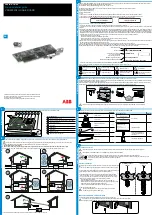
HOBO 4-Channel Pulse Input Data Logger Manual
© 2011–2013 Onset Computer Corporation. All rights reserved. Onset, HOBO, and HOBOware are
trademarks or registered trademarks of Onset Computer Corporation. All other trademarks are the
property of their respective companies.
14638-E
U-Shuttle to HOBOware. Refer to the HOBOware Help for more
details.
Recording Internal Logger Events
The logger records several internal events to help track logger
operation and status. These events, which are unrelated to
state and event logging, include the following:
Internal Event Name
Definition
Host Connected
The logger was connected to the computer.
Started
The Start/Stop button was pressed to begin
logging.
Stopped
The logger received a command to stop
recording data (from HOBOware or by
pushing the Start/Stop button).
Button Up/Button
Down
The Start/Stop button was pressed for
1
second.
Safe Shutdown
The battery level is 1.8 V; the logger shut
down.
Mounting the Logger
There are three ways to mount the logger using the materials
included:
•
Screw the logger to a surface with a Phillips-head
screwdriver and the four mounting screws, using the
following dimensions.
•
Attach the two magnets to the back of the logger and
then place the logger on a magnetic surface.
•
Use the hook-and-loop tape to affix the logger to a
surface.
Protecting the Logger
The logger is designed for indoor use and can be permanently
damaged by corrosion if it gets wet. Protect it from
condensation. If it gets wet, remove the battery immediately
and dry the circuit board. It is possible to dry the logger with a
hair dryer before reinstalling the battery. Do not let the board
get too hot. You should be able to comfortably hold the board
in your hand while drying it.
Note:
Static electricity may cause the logger to stop logging.
The logger has been tested to 4 KV, but avoid electrostatic
discharge by grounding yourself to protect the logger. For more
information, search for “static discharge” in the FAQ section on
onsetcomp.com.
Battery Information
The logger is shipped with two AA alkaline batteries. You can
also use 1.5 V AA lithium batteries when deploying the logger in
cold environments. Expected battery life varies based on the
temperature where the logger is deployed and the frequency
(the logging interval and the rate of state changes and/or
events) at which the logger is recording data. A new battery
typically lasts one year with logging intervals greater than one
minute and when the input signals are normally open or in the
high logic state. Deployments in extremely cold or hot
temperatures, logging intervals faster than one minute, or
continuously closed contacts may reduce battery life.
The logger can also be powered through the USB cable
connected to the computer. This allows you to read out the
logger when the remaining battery voltage is too low for it to
continue logging. Connect the logger to the computer, click the
Readout button on the toolbar, and save the data as prompted.
Replace the batteries before launching the logger again.
To replace the batteries:
1. Disconnect the logger from the computer.
2. Unscrew the logger case using a Philips-head screwdriver.
3. Carefully remove the two batteries.
4. Insert two new AA batteries (alkaline or lithium) observing
polarity. When batteries are inserted correctly, all LEDs blink
briefly.
5. Carefully realign the logger case and re-fasten the screws.
WARNING:
Do not cut open, incinerate, heat above 85°C
(185°F), or recharge the lithium batteries. The batteries may
explode if the logger is exposed to extreme heat or conditions
that could damage or destroy the battery cases. Do not dispose
of the logger or batteries in fire. Do not expose the contents of
the batteries to water. Dispose of the batteries according to
local regulations for lithium batteries.
HOBOware provides the option of recording the current battery
voltage at each logging interval, which is disabled by default.
Recording battery life at each logging interval takes up memory
and therefore reduces logging duration. It is recommended you
only record battery voltage for diagnostic purposes.
4.57 cm
(1.8 inches)
10.16 cm (4 inches)






















